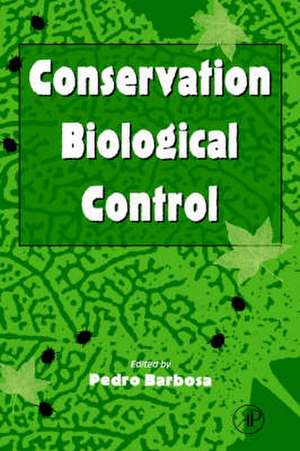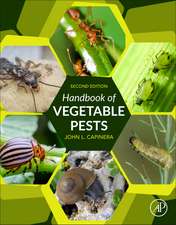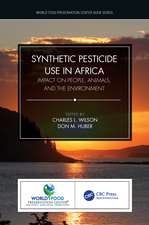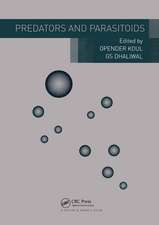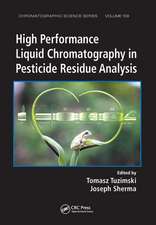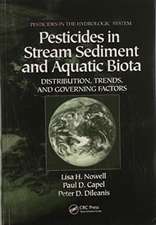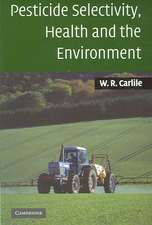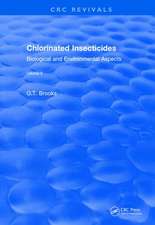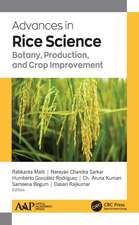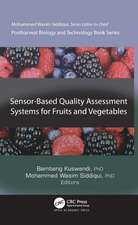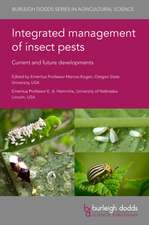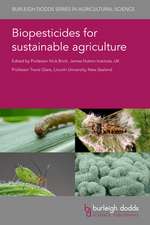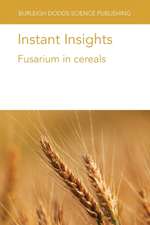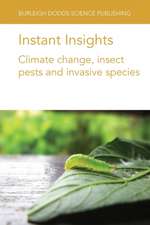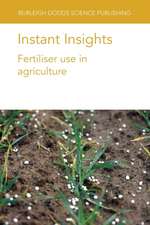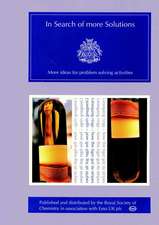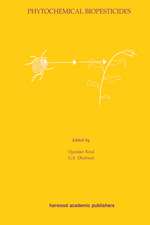Conservation Biological Control
Editat de Pedro A. Barbosaen Limba Engleză Hardback – 25 iun 1998
- Contains chapters by an international team of leading authorities
- Establishes a conceptual link between ecology and the agricultural use of agents for biological control
- Discusses both theoretical issues as well as practical management concerns
- Provides specific examples of how conservation principles are used to maximize the biological control of pests
Preț: 888.57 lei
Preț vechi: 1217.22 lei
-27% Nou
Puncte Express: 1333
Preț estimativ în valută:
170.04€ • 176.45$ • 142.13£
170.04€ • 176.45$ • 142.13£
Carte tipărită la comandă
Livrare economică 17-31 martie
Preluare comenzi: 021 569.72.76
Specificații
ISBN-13: 9780120781478
ISBN-10: 0120781476
Pagini: 396
Dimensiuni: 152 x 229 x 25 mm
Greutate: 0.74 kg
Ediția:00006
Editura: ELSEVIER SCIENCE
ISBN-10: 0120781476
Pagini: 396
Dimensiuni: 152 x 229 x 25 mm
Greutate: 0.74 kg
Ediția:00006
Editura: ELSEVIER SCIENCE
Public țintă
Audience: Entomologists, agriculturists, plant scientists, faculty researchers, and graduate students interested in biological control of pests. Institutions with strong programs in agricultural sciences, crop science, agronomy, entomology, and ecology.Cuprins
Introduction:
L.E. Ehler, Conservation Biological Control: Past, Present, and Future.
D. Letourneau, Conservation Biology: Lessons for Conserving Natural Enemies.
P. Barbosa, Agroecosystems and Conservation Biological Control.
Influence of Habitat: Underlying Ecological Interactions:
P. Barbosa and B. Benrey, The Influence of Plants on Insect Parasitoids: Implications to Conservation Biological Control.
P. Barbosa and S.D. Wratten, Influence of Plants on Invertebrate Predators: Implications to Conservation Biological Control.
D. Landis and F. Menalled, Ecological Considerations in the Conservation of Effective Parasitoid Communities in Agricultural Systems.
Influence of Habitat: Designing Strategies:
D.N. Ferro and J. McNeil, Habitat Enhancement and Conservation of Natural Enemies of Insects.
W. Nentwig, T. Frank, and C. Lethmayer, Sown Weed Strips: Artificial Ecological Compensation Areas as an Important Tool in Conservation Biological Control.
G. Gurr, H. van Emden, and S. Wratten, Habitat Manipulation and Natural Enemy Efficiency: Implications for the Control of Pests.
Influence of Agronomic and Management Considerations on Conservation Biological Control:
C. Hoy, J. Feldman, F. Gould, G. Kennedy, G. Reed, and J.A. Wyman, Naturally Occurring Biological Controls in Genetically Engineered Crops.
J.R. Ruberson, N. Nemoto, and Y. Hirose, Pesticides and Conservation of Natural Enemies in Pest Management.
Y. Hirose, Conservation Biological Control of Mobile Pests: Problems and Prospects.
Implementation of Conservation Biological Control:
Nemotodes:
E.E. Lewis, J.F. Campbell, and R. Gaugler, A Conservation Approach to Using Entomopathogenic Nematodes in Turf and Landscapes.
Insect Pathogens:
J.R. Fuxa, Environmental Manipulation to Increase Levels of Microbial Control of Insects.
Insects and Mites:
I. Perfecto and A. Castiñeiras, Deployment of the Predacious Ants, and Their Conservation in Ecosystems.
J.D. Dutcher, Conservation of Aphidophaga in Pecan Orchards.
J. Nyrop, G. English-Loeb, and A. Roda, Conservation Biological Control of Spider Mites in Perennial Cropping Systems.
Plant Pathogens:
C.L. Wilson, Conserving Epiphytic Microorganisms on Fruits and Vegetables for Biological Control.
P. Lucas and A. Sarniguet, Biological Control of Soil-Borne Pathogens with Resident versus Introduced Antagonists: Should Diverging Approaches Become Strategic Convergence?
Weeds:
R.M. Newman, D.C. Thompson, and D.B. Richman, Conservation Strategies for the Biological Control of Weeds.
Subject Index.
L.E. Ehler, Conservation Biological Control: Past, Present, and Future.
D. Letourneau, Conservation Biology: Lessons for Conserving Natural Enemies.
P. Barbosa, Agroecosystems and Conservation Biological Control.
Influence of Habitat: Underlying Ecological Interactions:
P. Barbosa and B. Benrey, The Influence of Plants on Insect Parasitoids: Implications to Conservation Biological Control.
P. Barbosa and S.D. Wratten, Influence of Plants on Invertebrate Predators: Implications to Conservation Biological Control.
D. Landis and F. Menalled, Ecological Considerations in the Conservation of Effective Parasitoid Communities in Agricultural Systems.
Influence of Habitat: Designing Strategies:
D.N. Ferro and J. McNeil, Habitat Enhancement and Conservation of Natural Enemies of Insects.
W. Nentwig, T. Frank, and C. Lethmayer, Sown Weed Strips: Artificial Ecological Compensation Areas as an Important Tool in Conservation Biological Control.
G. Gurr, H. van Emden, and S. Wratten, Habitat Manipulation and Natural Enemy Efficiency: Implications for the Control of Pests.
Influence of Agronomic and Management Considerations on Conservation Biological Control:
C. Hoy, J. Feldman, F. Gould, G. Kennedy, G. Reed, and J.A. Wyman, Naturally Occurring Biological Controls in Genetically Engineered Crops.
J.R. Ruberson, N. Nemoto, and Y. Hirose, Pesticides and Conservation of Natural Enemies in Pest Management.
Y. Hirose, Conservation Biological Control of Mobile Pests: Problems and Prospects.
Implementation of Conservation Biological Control:
Nemotodes:
E.E. Lewis, J.F. Campbell, and R. Gaugler, A Conservation Approach to Using Entomopathogenic Nematodes in Turf and Landscapes.
Insect Pathogens:
J.R. Fuxa, Environmental Manipulation to Increase Levels of Microbial Control of Insects.
Insects and Mites:
I. Perfecto and A. Castiñeiras, Deployment of the Predacious Ants, and Their Conservation in Ecosystems.
J.D. Dutcher, Conservation of Aphidophaga in Pecan Orchards.
J. Nyrop, G. English-Loeb, and A. Roda, Conservation Biological Control of Spider Mites in Perennial Cropping Systems.
Plant Pathogens:
C.L. Wilson, Conserving Epiphytic Microorganisms on Fruits and Vegetables for Biological Control.
P. Lucas and A. Sarniguet, Biological Control of Soil-Borne Pathogens with Resident versus Introduced Antagonists: Should Diverging Approaches Become Strategic Convergence?
Weeds:
R.M. Newman, D.C. Thompson, and D.B. Richman, Conservation Strategies for the Biological Control of Weeds.
Subject Index.
Recenzii
"This collection of papers by leading authorities in pest control and management takes the unique approach of using conservation biology as the central theme. The different sections are all well written and provide insights into the efforts to both conserve natural enemies and control pests through conservation biological control (e.g., strip-harvesting of alfalfa, etc.). The authors point out the value of this approach and the difficulties involved with its application under current agricultural and economic systems." --D.W. Kitchen in CHOICE, April 1999
"The timeliness of Conservation Biological Control is striking. The suggested alternative approach to biological-based management of invasive species is exciting in its ecological justification and its sustainability. This book is an excellent introduction to the current state-of-the-art in the preservation, facilitation, and augmentation of native natural enemies as biological controls." --Svata M. Louda in ECOLOGY, July 1999
"...Barbosa has successfully co-ordinated an international group of authors to provide a comprehensive coverage of a wide selection of topics from the ecological basis of the subject, and its practical application, through to the constraints on uptake and the problems of compatibility with the economics of cropping systems. There is, however, a lot of interesting science in this book and this reviewer thinks that the content of many of the well referenced chapters will be of interest to ecologists as well as biological control specialists." --BIOCONTROL NEWS AND INFORMATION
"The timeliness of Conservation Biological Control is striking. The suggested alternative approach to biological-based management of invasive species is exciting in its ecological justification and its sustainability. This book is an excellent introduction to the current state-of-the-art in the preservation, facilitation, and augmentation of native natural enemies as biological controls." --Svata M. Louda in ECOLOGY, July 1999
"...Barbosa has successfully co-ordinated an international group of authors to provide a comprehensive coverage of a wide selection of topics from the ecological basis of the subject, and its practical application, through to the constraints on uptake and the problems of compatibility with the economics of cropping systems. There is, however, a lot of interesting science in this book and this reviewer thinks that the content of many of the well referenced chapters will be of interest to ecologists as well as biological control specialists." --BIOCONTROL NEWS AND INFORMATION
